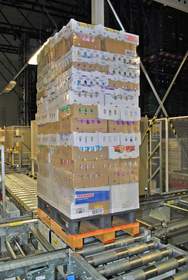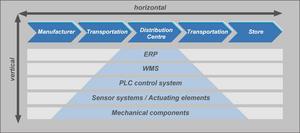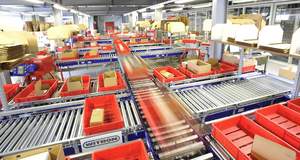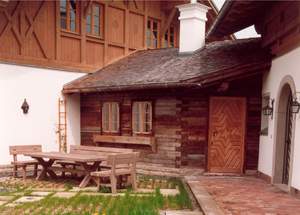ARLINGTON HEIGHTS, IL--(Marketwire - March 9, 2010) - Highly dynamic picking systems and green logistics are not mutually exclusive. The Parkstein logisticians from Witron have been proving this for many years now. "The energy efficiency of a logistics plant has long ceased to be a minor factor in project placement decisions," according to Witron sales manager Ulrich Schlosser. "For the client these days, the topic is just as important as considerations of cost efficiency, ergonomics and throughput capacity for a plant. It makes no difference whether it is a project in Europe or in the USA.
"The client is calling for resource-efficient solutions, and we as the general contractor are required to offer them. And the investment costs incurred by the client must be no higher than with conventional technology."
For more than 10 years now, rising energy prices, environmental aspects and sustainability have been considered by Witron as matters of immense importance in the planning of cost-effective overall concepts. "We have internalised environmental considerations at Witron. This is reflected in the region we come from, the down-to-earth attitude of the people who live here, as well as in our company buildings -- 'Green Logistics' is not a passing trend for us, but instead a part of our corporate philosophy," boasts Schlosser.
To enable Witron to achieve logistics concepts that are green in every respect, it is vital that the entire process chain and the various system hierarchies are considered as a whole, both vertically and horizontally (see accompanying chart). This is the only way that holistic 3E (Economy, Ergonomics and Environment) solutions can be created.
This begins with logistics planning and continues with the inclusion of all subsequent hierarchies from the software level to the control level and through to the level of components and mechanical systems. Even the conveyors, tote stacker cranes and COM machines used by Witron are developed and manufactured by its own subsidiary FAS. "Consequently, market requirements can be incorporated directly into the mechanical components produced specifically for Witron solutions. This is a big advantage with the conception and application of environmentally friendly technologies," explains Ulrich Schlosser.
Energy efficiency at planning level
With many Witron solutions, compact storage and short conveyor lines mean that space requirements in the distribution centre are reduced by up to 50% or more compared to conventional warehouse systems. This enables considerable cost savings to be generated in the energy sector, particularly in frozen and temperature-controlled storage areas.
There is also potential for high energy savings in optimising the material flow in a logistics plant For example, in the latest OPM generation, several load handling devices are grouped together to create one transport unit on the conveyor. This significantly reduces the length of time that the conveyor elements are switched on and lowers the plant's energy consumption by up to 30%. Thanks to this measure, 40% fewer drives are needed in an OPM system.
What is more, a precisely planned material flow solution using the intelligent combination of different logistics modules and the variable positioning of the articles using the order structure not only lead to optimised paths for stacker cranes and shorter throughput times, they also result in fewer case transport trips on the conveyor. More importantly, the generation of densely packed pallets/load carriers and optimal utilisation of the transport space on the shipping trailer results in a significant reduction in trucking journeys leading to reduced transportation costs.
But energy-efficient project planning is not just for new facilities. This issue also plays an important role in the refurbishment of old plants and maintenance of the "installed base." For example, Witron prepares a so-called energy balance sheet of existing installations for its clients when conducting energy audits. Witron experts specialising in energy topics check the infrastructure of the logistics centre on the client's premises, including all components and processes, in order to then devise a sustainable optimisation concept.
Energy efficiency at software level
"As a general contractor able to deliver both the software and the mechanical system from a single source, we have the means not only to build the mechanical system with a low energy consumption but also to control it efficiently -- which means twice the pay-off for our clients," comments Ulrich Schlosser in reference to the economic benefits of environmentally conscious technologies provided by Witron.
"Effective software functionalities, such as in the area of volume costing, order combining or the use of pick-and-pack functionalities at the picking workstations can also be seen by the client in its CO² balance sheet," says Schlosser. "The use of efficient automated logistics solutions reduces the number of outbound deliveries by 10% to 20% because load carriers are packed densely." The net result is significant savings in terms of energy costs as well as CO² emissions.
An exact analysis and distribution of the articles in accordance with the ABC article structure in the warehouse as well as storage two-deep or four-deep in the ASW area reduce the number of crane trips and minimise distances.
Considerable savings potential is exploited if the plant runs in so-called economy mode. In low-throughput phases of plant areas, the stacker cranes deliberately accelerate more slowly -- and only to a lower speed -- while the paths are further optimised. This reduces not only energy consumption, but also wear and tear to the vehicles.
Energy efficiency at control level
Energy-optimised lifting and travel gear axles on the vehicles make it possible to raise the lifting mechanism during the decelerating phase of the drive unit and lower it during the accelerating phase. This technology has been in use for 10 years and has increased vehicle efficiency by up to 30%.
By combining several controllers and vehicles to create one entity, this enables excess energy generated when decelerating a vehicle to be used directly for the acceleration of another vehicle. This leads to cross-component energy optimisation. The effect is particularly appealing to clients in instances where energy cannot be fed back to the grid or the energy recovery is not compensated by the energy supplier.
Energy efficiency at component level
The tote conveyors, elevators and transfer cars manufactured by FAS incorporate a number of energy-saving aspects when it comes to upgrades and new developments. The significantly enhanced efficiency provided by gearless drives and the improved start-up performance (based on the use of frequency converters) bring quantifiable advantages for the operator.
The majority of elevators and transfer cars used by Witron are fitted with energy recovery units. In current projects, the use of synchronous drives in the conveyors is a permanent fixture in Witron solutions. Synchronous drives reduce the energy requirement by increasing efficiency in the partial load range and making the size of the motor up to 40% smaller.
Through the application of stacker cranes with energy recovery units, it has become possible to reduce their energy demand by as much as 60%. A plant with more than 160 vehicles in one location has operated successfully with this technology since 1999. The use of gearless drives and optimum torque utilisation in the COM machines, conveyors and accumulation drives has meant a reduction of up to 25% less energy than technologies previously used.
The application of PLC-controlled, autonomous accumulation drives removes the need for a main accumulating roller conveyor drive that is always running. The individual conveyor segments run in economy mode; in other words, they only run when there are goods being transported on them. Consequently, the energy requirement depends solely on the number of transport units carried. This completely resolves the issue of no-load times.
Energy-saving solutions also incorporate the aspects of sensor equipment and actuators at component level. In terms of actuators, Witron stopped using pneumatic drives long ago. The reason for this is poor efficiency in compressed air production and distribution.
Summary
Witron sales manager Ulrich Schlosser is keen to reiterate the company's commitment to using environmentally friendly technologies. "When it comes to using resource-efficient solutions, we have placed great demands and obligations on ourselves," says Ulrich Schlosser in reference to the high priority awarded to the further development of energy-efficient logistics solutions. "Innovative logistics solutions with minimal energy consumption provide competitive advantages for our clients, for Witron and, most notably, for our environment."
Witron Logistik + Informatik GmbH -- a short portrait
Founded in 1971, Witron Logistik + Informatik GmbH, headquartered in Parkstein (Upper Palatinate/Eastern Bavaria), is a leading company in the planning and realisation of automated logistics system solutions. Numerous national and international market leaders from trade and industry rely on the interdisciplinary and cross-sector expertise that Witron has managed to amass in 39 years through the implementation of more than 2,000 specialised logistics projects in a vast range of fields in the business world. As general contractor, Witron is responsible for the budget, schedule and functions throughout all phases of the project: from conception and planning to assembly and full realisation of the logistics plant, and right through to the subsequent plant ramp-up phase. Even after the project has been completed, users continue to have access to Witron's know-how during the entire lifecycle of their plant thanks to a customer support partnership.
The Witron Corporate Group has 1,100 employees worldwide. Annual sales in 2008 amounted to EUR 200 million. Additional branches for Business Development and Customer Support are located in Arlington Heights/Illinois (USA), Toronto (Canada), Venray (the Netherlands), Madrid (Spain) and High Wycombe (UK).
Contact Information:
For editorial questions, please contact:
Mr. Sean O'Farrell
Business Development Manager
Tel. 847-385-6000
E-Mail:
WITRON Integrated Logistics Corporation
3721 Ventura Drive
Arlington Heights IL 60004



